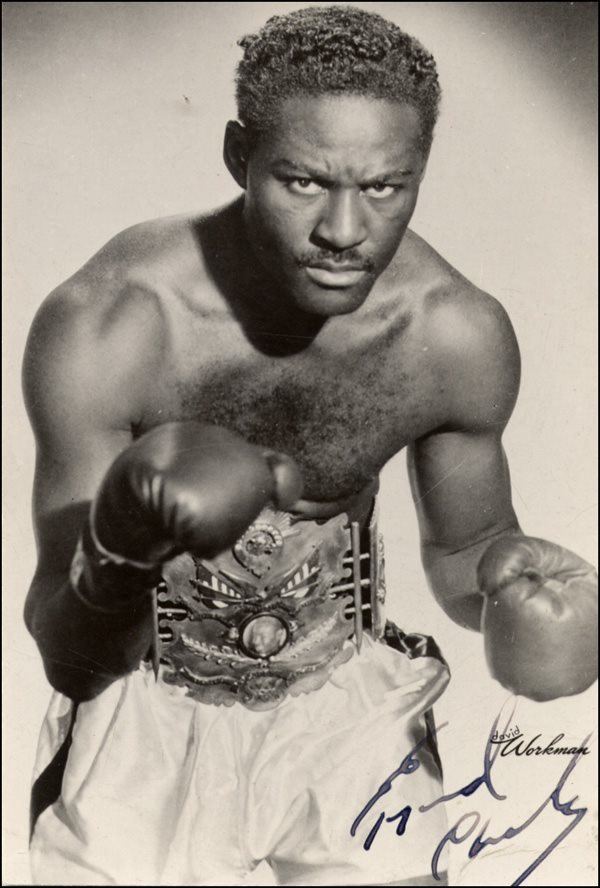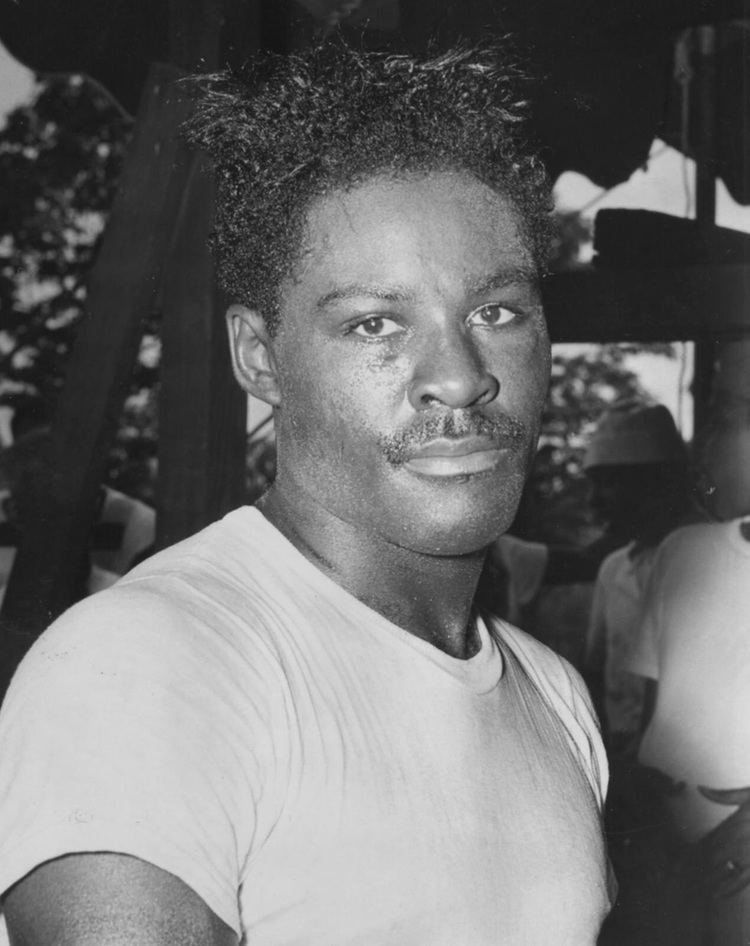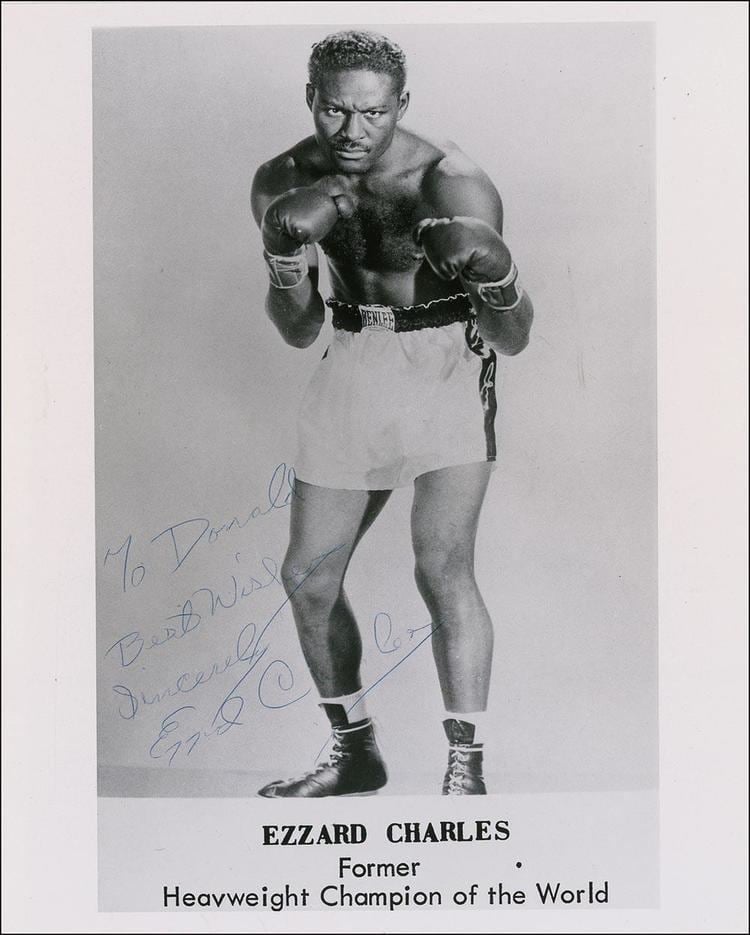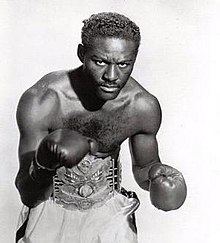Real name Ezzard Mack Charles Weight 91 kg Name Ezzard Charles | Reach 73 in (185 cm) Role Professional Boxer Trained by Ray Arcel Nationality American Height 1.83 m | |
 | ||
Rated at MiddleweightLight HeavyweightHeavyweight Born July 7, 1921Lawrenceville, Georgia, U.S. ( 1921-07-07 ) Died May 28, 1975, Chicago, Illinois, United States Similar People | ||
Forgotten warriors 5 ezzard charles
Ezzard Mack Charles (July 7, 1921 – May 28, 1975) was an American professional boxer and former World Heavyweight Champion.
Contents
- Forgotten warriors 5 ezzard charles
- Joe louis vs ezzard charles
- Career
- Career beginnings and military service
- World heavyweight champion
- Charles vs Marciano
- Later career
- Death
- Legacy
- References

Charles defeated numerous Hall of Fame fighters in three different weight classes. He retired with a record of 95 wins, 25 losses and 1 draw.

Joe louis vs ezzard charles
Career

He was born in Lawrenceville, Georgia, but is commonly thought of as a Cincinnatian. Charles graduated from Woodward High School in Cincinnati where he was already becoming a well-known fighter. Known as "The Cincinnati Cobra", Charles fought many notable opponents in both the light heavyweight and heavyweight divisions, eventually winning the World Championship in the latter. Although he never won the Light Heavyweight title, The Ring has rated him as the greatest light heavyweight of all time.
Career beginnings and military service

Charles started his career as a featherweight in the amateurs, where he had a record of 42–0. In 1938, he won the Diamond Belt Middleweight Championship. He followed this up in 1939 by winning the Chicago Golden Gloves tournament of champions. He won the national AAU Middleweight Championship in 1939. He turned pro in 1940, knocking out Melody Johnson in the fourth round. Charles won all of his first 15 fights before being defeated by veteran Ken Overlin. Victories over future Hall of Famers Teddy Yarosz and the much avoided Charley Burley had started to solidify Charles as a top contender in the middleweight division. However, he served in the U.S. military during World War II and was unable to fight professionally in 1945.
World heavyweight champion
He returned to boxing after the war as a light heavyweight, picking up many notable wins over leading light heavyweights, as well as heavyweight contenders Archie Moore, Jimmy Bivins, Lloyd Marshall and Elmer Ray. Shortly after his knock-out of Moore in their third and final meeting, tragedy struck. Charles fought a young contender named Sam Baroudi, knocking him out in Round 10. Baroudi died of the injuries he sustained in this bout. Charles was so devastated he almost gave up fighting. Charles was unable to secure a title shot at light heavyweight and moved up to heavyweight. After knocking out Joe Baksi and Johnny Haynes, Charles won the vacant National Boxing Association Heavyweight title when he outpointed Jersey Joe Walcott over 15 rounds on June 22, 1949. The following year, he outpointed his idol and former World Heavyweight Champion Joe Louis to become the recognized Lineal Champion. Successful defenses against Walcott, Lee Oma and Joey Maxim would follow.
Charles vs. Marciano
In 1951, Charles fought Walcott a third time and lost the title by knockout in the seventh round. Charles lost a controversial decision in their fourth and final bout. If Charles had won this fight, he would have become the first man in history to regain the heavyweight championship. Remaining a top contender with wins over Rex Layne, Tommy Harrison and Coley Wallace, Charles knocked out Bob Satterfield in an eliminator bout for the right to challenge Heavyweight Champion Rocky Marciano. His two stirring battles with Marciano are regarded as ring classics. In the first bout, held in June 1954, he valiantly took Marciano the distance, going down on points in a vintage heavyweight bout. Charles is the only man ever to last the full 15-round distance against Marciano. A number of fans and boxing writers felt that Charles deserved the decision. In their September rematch, Charles landed a severe blow that literally split Marciano's nose in half. Marciano's cornermen were unable to stop the bleeding and the referee almost halted the contest until Marciano rallied with an eighth-round knockout.
Later career
Financial problems forced Charles to continue fighting, losing 13 of his final 23 fights (He held a record of 83 wins, 12 losses and 1 draw before financial problems became a factor in his career). He retired with a record of 93-25-1 (52 KOs).
Charles was also a respected double bass player who played with some of the jazz greats in the 1940s and 1950s at such notable places as Birdland (jazz composer George Russell wrote the famous tune "Ezz-Thetic" in his honor). He was very close with Rocky Marciano and a neighbor and friend of Muhammad Ali when they both lived on 85th Street in Chicago. Charles also starred in one motion picture: Mau Mau Drums, an independent (and unreleased) jungle-adventure film shot in and around Cincinnati in 1960 by filmmaker Earl Schwieterman.
Death
In 1968, Charles was diagnosed with amyotrophic lateral sclerosis, also known as Lou Gehrig's disease. The disease affected Charles' legs and eventually left him completely disabled. A fund raiser was held to assist Charles and many of his former opponents spoke on his behalf. Rocky Marciano in particular called Charles the bravest man he ever fought. The former boxer spent his last days in a nursing home. A chilling 1973 commercial showed Charles in his wheelchair horribly disabled by the disease. Charles died on May 28, 1975, in Chicago.
Legacy
In 1976, Cincinnati honored Charles by changing the name of Lincoln Park Drive to Ezzard Charles Drive. This was the street of his residence during the height of his career.
He was elected to the International Boxing Hall of Fame in 1990.
In 2002, Charles was ranked #13 on The Ring magazine's list of the 80 Best Fighters of the Last 80 Years.
In 2006, Ezzard Charles was named the 11th greatest fighter of all time by the IBRO (International Boxing Research Organisation).
The "Cincinnati Cobra" was a master boxer of extraordinary skill and ability. He had speed, agility, fast hands and excellent footwork. Charles possessed a masterful jab and was a superb combination puncher. He was at his peak as a light-heavyweight. His record is quite impressive. Against top rate opposition like Archie Moore, Charley Burley, Lloyd Marshall, Jimmy Bivins, and Joey Maxim he was an impressive 16-2 combined. Despite being a natural light-heavy he won the heavyweight title and made 9 successful title defenses. Nearly 25% of voters had Charles in the top 10. Half of the voters had him in the top 15. Two thirds of voters had him inside the top 20.
In 2007, ESPN online ranks Ezzard Charles as the 27th greatest boxer of all time, ahead of such notable fighters as Mike Tyson, Larry Holmes and Jake LaMotta.
In 2009, Boxing magazine listed Ezzard Charles as the greatest Light Heavyweight fighter ever, ahead of the likes of Archie Moore, Bob Foster, Michael Spinks and Gene Tunney.
Prominent boxing historian Bert Sugar listed Charles as the seventh greatest Heavyweight of all time.
